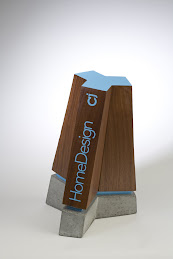I say adventure because I'm not sure this will turn out. Here is the bamboo tiki light I am attempting to turn into a concrete tiki light holder. I need to build a mold for the rubber (the easy part) and make the lamp water tight (the hard part).
 Here we go, two part polyurethane used to make durable and reusable concrete stamps and molds. It's not cheap but if the mold turns out, I will be able to make a bunch of these to help defray the cost.
Here we go, two part polyurethane used to make durable and reusable concrete stamps and molds. It's not cheap but if the mold turns out, I will be able to make a bunch of these to help defray the cost.  On the left the mold for the mold. On the right, the sealed tikiman. I backed the face area with masking tape and filled in the light bulb access and cord holes with molding clay.
On the left the mold for the mold. On the right, the sealed tikiman. I backed the face area with masking tape and filled in the light bulb access and cord holes with molding clay. Then I sprayed everything with a liberal shot of silicone mold release and glued them down. Per manufacturers suggestion there is 1/2inch between the mold and the tikiman. Once the polyurethane is set I will split it in two halves to remove the bamboo.
Then I sprayed everything with a liberal shot of silicone mold release and glued them down. Per manufacturers suggestion there is 1/2inch between the mold and the tikiman. Once the polyurethane is set I will split it in two halves to remove the bamboo.














 After a few more cans of spray foam and sanding, the shape was pretty close. This reminds me of building the molds for concrete canoes, although on a much smaller scale. The bottom square is the 3" mounting base. Then the table underside tapers from 2 inches thick in the middle to 1 inch at the edge. Since the foam is hard to get real smooth and with a short
After a few more cans of spray foam and sanding, the shape was pretty close. This reminds me of building the molds for concrete canoes, although on a much smaller scale. The bottom square is the 3" mounting base. Then the table underside tapers from 2 inches thick in the middle to 1 inch at the edge. Since the foam is hard to get real smooth and with a short 


























